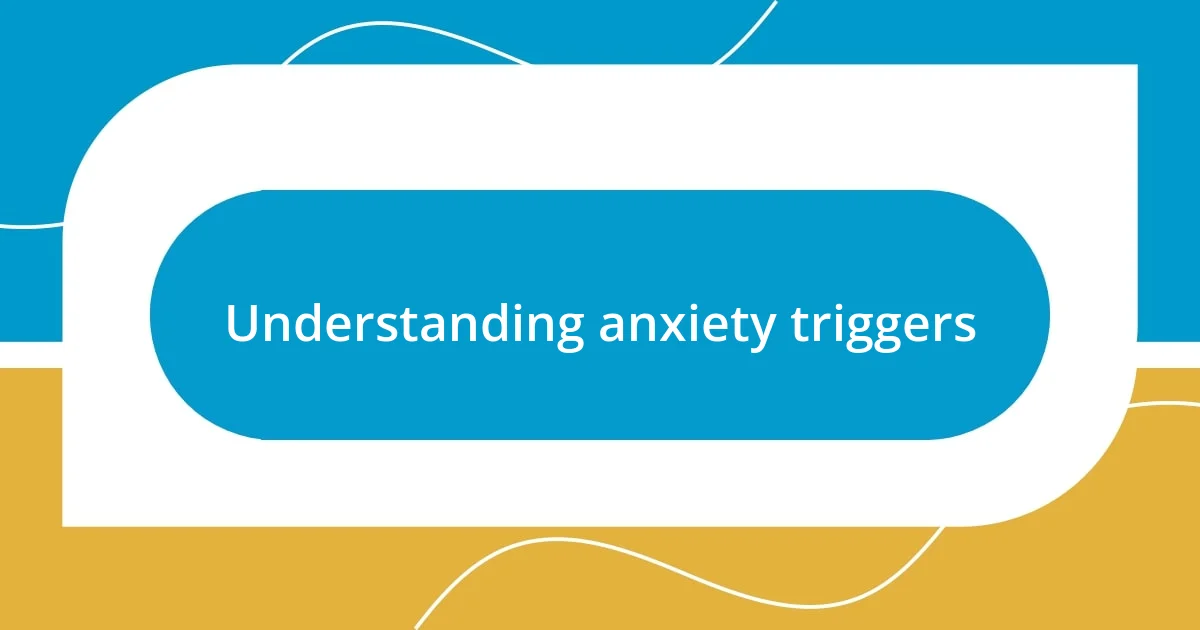Key takeaways:
- Identifying personal anxiety triggers, both external and internal, is crucial for effective anxiety management.
- Developing coping strategies such as journaling, grounding techniques, and seeking social support can significantly help alleviate anxiety symptoms.
- Regularly reviewing and adjusting coping methods ensures a dynamic approach to managing anxiety tailored to one’s evolving needs.

Understanding anxiety triggers
Understanding anxiety triggers is essential in managing anxiety effectively. For me, noticing my triggers often feels like a scavenger hunt for hidden treasures of self-awareness. I remember the first time I recognized that crowds were a significant trigger for me; it felt liberating. Have you ever paused amidst a busy room and felt the weight of unease creeping in, only to realize it’s the sheer number of faces that unsettle you?
Often, I find that my triggers aren’t just external situations but also thoughts and patterns I fall back into. For instance, when I dwell on past mistakes, I can practically feel my heart race as anxiety takes the wheel. It raises the question: What internal narratives fuel your anxiety? Occasionally, I wonder if we create our own triggers through unhelpful self-talk, making it vital to pay attention to both our surroundings and inner dialogue.
There was a time when I didn’t connect the dots between my daily coffee intake and my feelings of anxiety later on. Cutting back on caffeine transformed my experience; it was like turning down the volume on anxiety’s soundtrack. What have you identified in your life that acts as a trigger? Recognizing these patterns has been a game changer for me and can be for you, too.

Identifying personal coping strategies
Identifying personal coping strategies can be an enlightening journey. I’ve learned that journaling helps me untangle the web of my anxious thoughts. When I put pen to paper, I often discover hidden patterns that I didn’t realize were there. Can you recall a time when writing clarified your feelings? For me, it became a crucial tool; the act of externalizing chaos offers a sense of control.
Another strategy I’ve found effective is grounding techniques. When anxiety strikes, I focus on my surroundings by naming five things I can see, four things I can touch, three things I can hear, two things I can smell, and one thing I can taste. This exercise brings me back to the present moment and reduces the overwhelming tidal wave of worry. I remember sitting on a park bench, utilizing this method, and feeling an immediate sense of relief wash over me. Have you tried similar techniques that anchor you in the here and now?
Lastly, I can’t stress enough the value of connecting with others. Sharing my feelings with a close friend often transforms my experience. I vividly recall a long evening of venting about my anxieties; by the end, it felt as if a weight was lifted from my chest. Have you reached out to someone when anxiety was at its peak? Finding those who understand can turn a silent battle into a shared journey, making those heavy burdens feel lighter.
| Strategy | Personal Experience |
|---|---|
| Journaling | Unraveling anxious thoughts and uncovering patterns |
| Grounding Techniques | Bringing focus back to the present moment |
| Connecting with Others | Transforming anxiety through shared experiences |

Practicing mindfulness techniques
Practicing mindfulness techniques
In my experience, practicing mindfulness can be a game changer for managing anxiety. I remember a particularly stressful day when the waves of anxiety threatened to pull me under. I simply closed my eyes, took a deep breath, and focused on the rhythm of my breathing. The moment felt like hitting a “pause” button on my racing thoughts. Have you ever stopped to truly feel your breath—the way it enters and leaves your body?
Incorporating mindfulness into my daily routine has equipped me with tools to ground myself amid anxiety. Here are a few techniques I regularly use:
-
Breath Awareness: Focusing on my breath helps me reconnect with the present. I often set a timer for five minutes, simply inhaling and exhaling, which works wonders for calming my mind.
-
Body Scan: This technique involves mentally scanning my body from head to toe, inviting relaxation into any areas of tension. I find this particularly useful before bed, helping me unwind.
-
Mindful Walking: Sometimes, I take a stroll and concentrate on the sensation of my feet touching the ground. It’s amazing how observing the sounds and sights around can shift my perspective.
-
Gratitude Journaling: Each night, I jot down three things I’m grateful for. Reflecting on positive moments helps me balance the heaviness of anxiety with light.
When I engage in these practices, it’s like wrapping myself in a comforting blanket, providing a sense of safety amidst the chaos of my thoughts. What mindfulness techniques have you explored that help you find your center?

Incorporating physical activity
Incorporating physical activity into my routine has truly been transformative for managing anxiety. I remember a particularly anxious week when I felt like I was spiraling. On a whim, I decided to go for a run. As I hit the pavement, I could feel the adrenaline pumping through my veins, drowning out the noise of my racing thoughts. Have you ever experienced that rush of endorphins after a good workout? It’s like a natural high that can momentarily push anxiety to the backseat.
Yoga has also become a staple in my anxiety management. I vividly recall one morning session when I was struggling with overwhelming feelings of pressure. As I flowed through the poses, I felt each deep breath anchor me in the moment. The combination of movement and breath created a grounding effect that I never expected. How about you? Have you ever tried yoga as a means to restore your balance? It’s fascinating how such a simple yet intentional practice can serve as a refuge amidst life’s chaos.
Even short bursts of physical activity can make a difference. On particularly tough days, I’ll opt for a quick 10-minute dance party in my living room. Sure, it might look silly, but there’s something freeing about letting loose to my favorite tunes. I find myself smiling and laughing by the end, the worries starting to fade away. Have you ever allowed yourself to just be playful? It goes to show that sometimes, a little movement can lead to a big shift in perspective.

Establishing a support system
Building a solid support system has been essential for me in navigating the complexities of anxiety. I remember feeling utterly isolated during a particularly tough period, believing no one truly understood what I was going through. One evening, I reached out to a close friend who had also experienced anxiety. Sharing our stories not only lightened the burdens we carried but also created a sense of camaraderie that I desperately needed. Have you ever found solace in talking with someone who gets it? The validation we seek can often come from those who have walked a similar path.
I’ve also learned the power of joining community groups focused on mental health. Attending a local meet-up feels like stepping into a safe haven where our struggles are acknowledged without judgment. The warmth of shared experiences fosters an environment that encourages vulnerability and growth. It’s incredible how just hearing someone else’s journey can spark hope. Think about it: have you ever attended a group where the collective energy elevated your spirits? Those connections have been lifelines for me.
Moreover, I encourage establishing a routine with loved ones. Whether it’s a weekly coffee catch-up or simply checking in through text, knowing someone is there for me makes a world of difference. I’ve often found comfort in just having someone listen, even if no solutions are presented. The act of being heard can be profoundly soothing, don’t you think? Building a network of support transforms anxiety from a solitary battle into a shared journey.

Seeking professional help
Seeking professional help can feel daunting, but I’ve come to realize that it’s a crucial step in managing anxiety. I still remember the first time I stepped into a therapist’s office, my heart racing with anticipation and uncertainty. It was intimidating, yet there was something liberating about finally having someone to talk to who understood without judgment. Have you ever felt that mix of fear and hope when reaching out for help? It’s a profound moment that can set the stage for real progress.
Working with a mental health professional has equipped me with coping strategies that I wouldn’t have discovered on my own. For instance, cognitive-behavioral therapy (CBT) introduced me to the concept of challenging negative thought patterns. I recall a session where we addressed an anxious thought that seemed to dictate my actions. As we unpacked it together, I felt the weight lift; having an expert guide me through my mind’s maze was incredibly enlightening. How often do we need someone to help us reframe our thinking?
Moreover, medication can be a valuable option for many. There was a time when I hesitated to consider it, worried about dependency and side effects. However, after discussing my concerns with my doctor, I felt more informed and empowered to make a decision. It was a game-changer, giving me the mental space to work on my anxiety actively. Have you explored if medication might be the right fit for you? Seeking professional advice ensures you’re making the best choices tailored to your needs.

Reviewing progress and adjusting methods
One of the most eye-opening experiences I had was when I committed to regularly reviewing my progress in coping with anxiety. I remember sitting down one Sunday afternoon, pen in hand, reflecting on my week. It was fascinating to note what strategies worked well and which ones felt less effective. Have you ever taken a moment to really dissect your journey? This process not only highlighted my growth but also illuminated the areas needing adjustment.
As I assessed my methods, I noticed that some approaches had become stale over time. For example, while journaling initially brought me clarity, I found myself reluctant to write. I decided to switch to voice memos instead, capturing my thoughts audibly. What a refreshing change that was! I’ve learned that flexibility in my coping strategies is essential. How often do we cling to old methods long after they’ve served their purpose?
Adjusting my approach has become a vital part of my anxiety management. I like to think of it as a dance; sometimes I lead, and other times I follow the rhythm of what feels right. Monitoring my mood daily has helped me identify when certain techniques need a tweak or a complete overhaul. Mapping out my wellness journey allows me to dance to the beat of my own needs, don’t you agree? This dynamic process of reviewing and adjusting has made my path to coping with anxiety feel less like a straight line and more like a vibrant journey.














